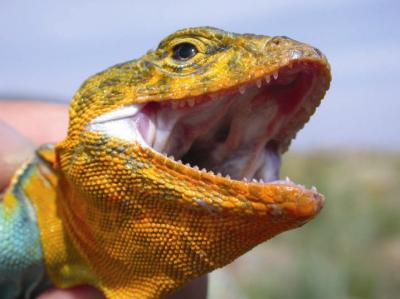Study shows that threat displays may prevent serious physical harm
Jun 20, 2006, 23:17, Reviewed by: Dr. Priya Saxena
|
|
"You see the same with humans. Think back to the rivalries of adolescence. Fights took place in order to establish dominance relationships in the neighborhood, but the fights themselves were rare. Most of it was posturing and showing off, displays per se, that served to advertise physical prowess as well as to reinforce the consequences of previous confrontations."
|
By University of Chicago Press Journals,
In a paper from the July issue of The American Naturalist, Kristopher Lappin (Northern Arizona University), Yoni Brandt (University of Toronto), Jerry Husak (Oklahoma State University), Joe Macedonia (Arizona State University), and Darrell Kemp (James Cook University), demonstrate that a threat display can provide accurate information about the performance of a weapon.
Working at the Wichita Mountains National Wildlife Refuge in Oklahoma, the researchers showed that when an adult male lizard gapes his jaws at a rival male during an intense territorial interaction, information is made available to his opponent about how hard he can bite � indeed, the lizard's jaw muscles become clearly visible. Further, some lizards have evolved bright patches that reflect ultraviolet light, which lizards can see, to delineate the jaw muscles.
Lappin and colleagues point out that the information about bite force provided by the display does not correspond to body or head size because males of similar size can vary substantially in how hard they can bite. The display thus provides unique and honest information about weapon quality, as well as a mechanism for making the decision to fight or to back down. Adult male collared lizards (the species examined in this study) are larger than the females, have hypertrophied jaw muscles, and are highly territorial toward other males. All of this relates to males having evolved the ability to bite with great force, which means that they can seriously wound rivals in fights.
 |
| The colorful and robust head of an adult male eastern collard lizard (Crotaphytus collaris) from the Wichita Mountains National Wildlife Refuge. The partially unfolded, bright white mouth-corner patch accentuates the jaw muscles during gaping displays. Credit: Courtesy A.K. Lappin |
"When you've seen what these lizards can do to each other with their jaws, inflicting deep lacerations and even breaking bones, it makes sense that avoiding fights would be advantageous, even if you are likely to win," Lappin says.
When two competing males engage in a gaping display, each shows off its weapon while simultaneously affording an opportunity to evaluate its rival's weapon. In animals from insects to humans, such displays likely play an important role in assessing the risks associated with fighting, as well as in reinforcing the experiences of past fights with specific individuals.
"You see the same with humans," Lappin explains. "Think back to the rivalries of adolescence. Fights took place in order to establish dominance relationships in the neighborhood, but the fights themselves were rare. Most of it was posturing and showing off, displays per se, that served to advertise physical prowess as well as to reinforce the consequences of previous confrontations." 
- A. Kristopher Lappin, Yoni Brandt, Jerry F. Husak, Joseph M. Macedonia, and Darrell J. Kemp, "Gaping displays reveal and amplify a mechanically based index of weapon performance." The American Naturalist 167:7.
www.journals.uchicago.edu
For any corrections of factual information, to contact the editors or to send
any medical news or health news press releases, use
feedback form
Top of Page
|